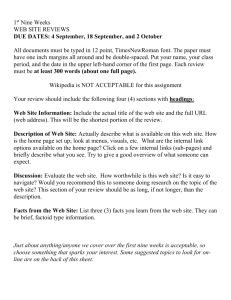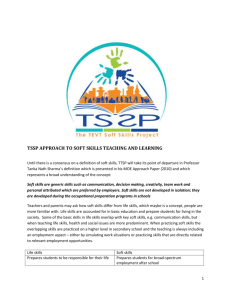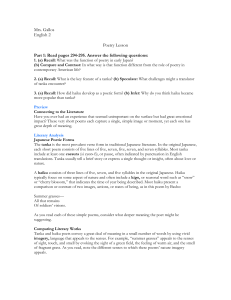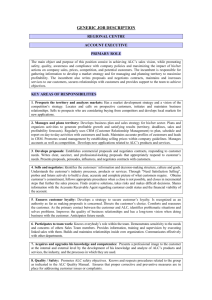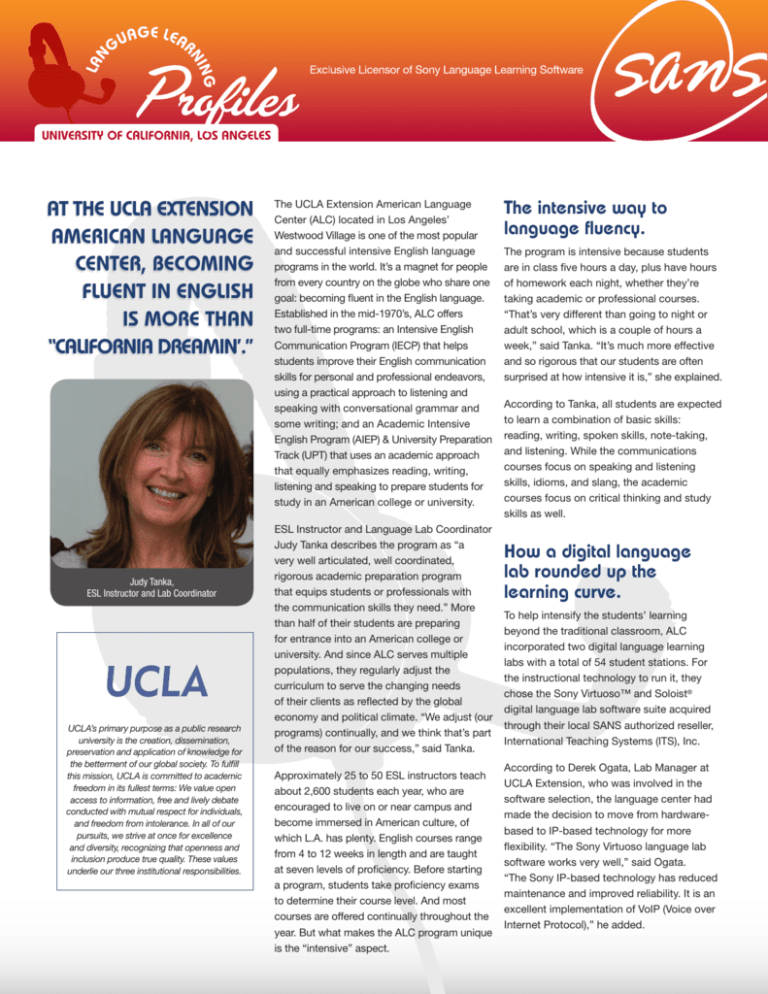
UNIVERSITY OF CALIFORNIA, LOS ANGELES
AT THE UCLA EXTENSION
AMERICAN LANGUAGE
CENTER, BECOMING
FLUENT IN ENGLISH
IS MORE THAN
“CALIFORNIA DREAMIN’.”
Judy Tanka,
ESL Instructor and Lab Coordinator
UCLA’s primary purpose as a public research
university is the creation, dissemination,
preservation and application of knowledge for
the betterment of our global society. To fulfill
this mission, UCLA is committed to academic
freedom in its fullest terms: We value open
access to information, free and lively debate
conducted with mutual respect for individuals,
and freedom from intolerance. In all of our
pursuits, we strive at once for excellence
and diversity, recognizing that openness and
inclusion produce true quality. These values
underlie our three institutional responsibilities.
The UCLA Extension American Language
Center (ALC) located in Los Angeles’
Westwood Village is one of the most popular
and successful intensive English language
programs in the world. It’s a magnet for people
from every country on the globe who share one
goal: becoming fluent in the English language.
Established in the mid-1970’s, ALC offers
two full-time programs: an Intensive English
Communication Program (IECP) that helps
students improve their English communication
skills for personal and professional endeavors,
using a practical approach to listening and
speaking with conversational grammar and
some writing; and an Academic Intensive
English Program (AIEP) & University Preparation
Track (UPT) that uses an academic approach
that equally emphasizes reading, writing,
listening and speaking to prepare students for
study in an American college or university.
ESL Instructor and Language Lab Coordinator
Judy Tanka describes the program as “a
very well articulated, well coordinated,
rigorous academic preparation program
that equips students or professionals with
the communication skills they need.” More
than half of their students are preparing
for entrance into an American college or
university. And since ALC serves multiple
populations, they regularly adjust the
curriculum to serve the changing needs
of their clients as reflected by the global
economy and political climate. “We adjust (our
programs) continually, and we think that’s part
of the reason for our success,” said Tanka.
Approximately 25 to 50 ESL instructors teach
about 2,600 students each year, who are
encouraged to live on or near campus and
become immersed in American culture, of
which L.A. has plenty. English courses range
from 4 to 12 weeks in length and are taught
at seven levels of proficiency. Before starting
a program, students take proficiency exams
to determine their course level. And most
courses are offered continually throughout the
year. But what makes the ALC program unique
is the “intensive” aspect.
The intensive way to
language fluency.
The program is intensive because students
are in class five hours a day, plus have hours
of homework each night, whether they’re
taking academic or professional courses.
“That’s very different than going to night or
adult school, which is a couple of hours a
week,” said Tanka. “It’s much more effective
and so rigorous that our students are often
surprised at how intensive it is,” she explained.
According to Tanka, all students are expected
to learn a combination of basic skills:
reading, writing, spoken skills, note-taking,
and listening. While the communications
courses focus on speaking and listening
skills, idioms, and slang, the academic
courses focus on critical thinking and study
skills as well.
How a digital language
lab rounded up the
learning curve.
To help intensify the students’ learning
beyond the traditional classroom, ALC
incorporated two digital language learning
labs with a total of 54 student stations. For
the instructional technology to run it, they
chose the Sony Virtuoso™ and Soloist®
digital language lab software suite acquired
through their local SANS authorized reseller,
International Teaching Systems (ITS), Inc.
According to Derek Ogata, Lab Manager at
UCLA Extension, who was involved in the
software selection, the language center had
made the decision to move from hardwarebased to IP-based technology for more
flexibility. “The Sony Virtuoso language lab
software works very well,” said Ogata.
“The Sony IP-based technology has reduced
maintenance and improved reliability. It is an
excellent implementation of VoIP (Voice over
Internet Protocol),” he added.
Tanka reports that teachers most commonly
use the recording features, which give them
the ability to instantly collect student
recordings, evaluate them, and give feedback.
“Monitoring is a very important feature as
well,” said Tanka. For example, Tanka gives
her students an exercise where they listen to
a recording that has pauses built in for them
to repeat or respond. “I definitely monitor
students and use the intercom feature to
speak to them individually,” she added.
“A feature we’ve learned about recently and
are eager to use is the ability to insert verbal
comments into a student’s recording right
where it’s needed. We think that’s a really
terrific feature,” said Tanka. “Students expect
a lot of feedback,” she added. “It needs to be
relevant. If a student makes a pronunciation
mistake, it’s most beneficial if the teacher
can insert comments right where the error
happened.”
Besides the recording and the collection
capability, Tanka said that the instructors like
the ability to pair students randomly in twos
or threes for conversation practice and to give
students individual feedback while in the lab.
Every student spends quality time in the lab,
but interestingly, the students with lower
levels of proficiency spend the most time
in the lab. “We feel that the lab allows
students to work at an individual pace and
get instant feedback from the teacher—
those are the kinds of things that the lower
levels need more of,” explained Tanka. They
also keep the lab open after school like a
library system, where students can spend
time working individually.
Teachers love the
monitoring features;
students love the feedback.
“Students love the lab and often ask for
more lab hours,” said Tanka. “They love the
autonomy of the lab, they want to control
their own learning, and they want the
feedback from the teacher that he/she is not
able to give in a class with 20 or 30 students.
So the students do see the benefit.
a unique program in which their students can
participate. The TOEFL exam tests English
language proficiency, and more than 8,000
colleges, universities and agencies in more
than 130 countries rely on TOEFL scores
to help make admission decisions. UCLA
Extension also uses the lab for interpretation/
translation courses.
An ALC instructor communicates with all students
simultaneously in the lab.
“And so do teachers, because it’s really
rewarding,” she continued. “You’re able
to individualize instruction and assign
communicative activities that you couldn’t
do in class. We do oral assessments of
grammar, for example. When you have
15-20 students in class, and you ask them
to talk about a picture and use a certain
grammatical structure, how can you monitor
the accuracy of their performance? You can
do it beautifully in the lab,” she explained.
SANS and ITS conduct periodic on-site
training sessions for the ALC faculty and IT
staff, and Ogata reports that the IT staff has
been very happy with the level of training
and support from both SANS and ITS. “The
technical help is really good,” said Ogata.
“The software interface is intuitively laid out,
which makes the functionality of the lab
simple to learn,” he added.
As language lab coordinator, Tanka takes
that training one step further by getting the
teachers excited about the technology. She
feels the key to achieving that is through
continued, incremental training and periodic
reminders of the features and how to use
them. She advises the teachers to always
think of activities to do in the lab that they
couldn’t do in a regular classroom, such
as conversation pairing, voice recording or
incorporating multi-media or the internet.
An interesting way in which ALC uses the lab
is to conduct pilot tests for the TOEFL® exam,
Preparing students for
personal, professional and
academic communication –
now and in the future...
What are future plans for ALC? “It would
be great to have another lab,” said Tanka.
“I would also like to see more video content
added onto our server, so teachers could do
more video-based lessons,” she added.
ALC also will be looking at a new SANS
technology, SANSSpace™ Virtual Language
Learning Environment, to extend the students’
learning to anywhere/anytime. SANSSpace
software provides both students and teachers
with web-based content management, a
digital comparative recorder for listening and
speaking practice, and both synchronous and
asynchronous collaboration tools. “I think with
the advanced capabilities of smart phones,
that’s where technology is going,” said Tanka.
“There is great potential for remote testing –
testing students before they get here, for their
level of placement. That’s something we would
love to do,” she added.
And based on the success of ALC for the past
35-plus years, this is a language center that is
sure to make those dreams a reality.
www.SANSINC.com
SANS Inc.
10 White Wood Lane
North Branford, CT 06471
©2013 SANS Inc All rights reserved. Reproduction in whole or in part without
written permission is prohibited. Virtuoso, Soloist and SANSSpace are
trademarks of Sony Electronics Inc. Sony Virtuoso and Soloist software
incorporate SANS and Sony technology. The names of other companies,
products and services are the property of their respective owners.
UCLA CS-0113


